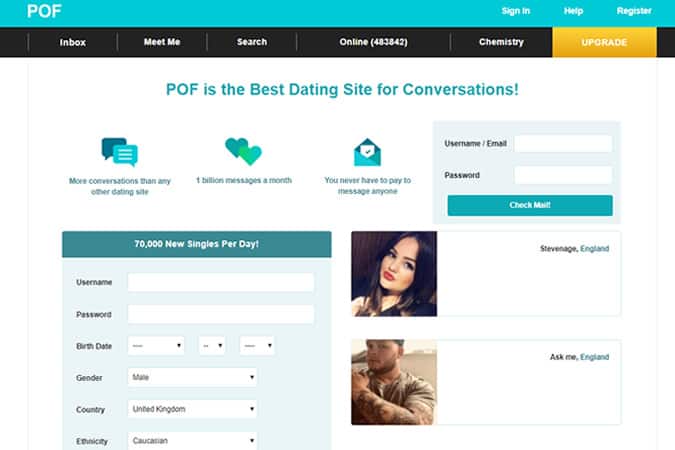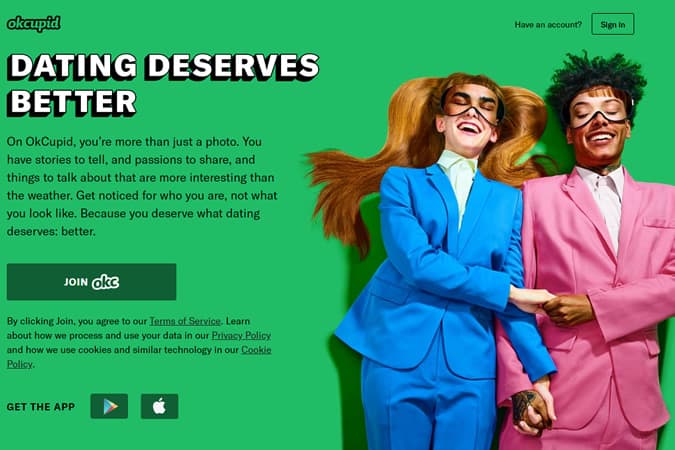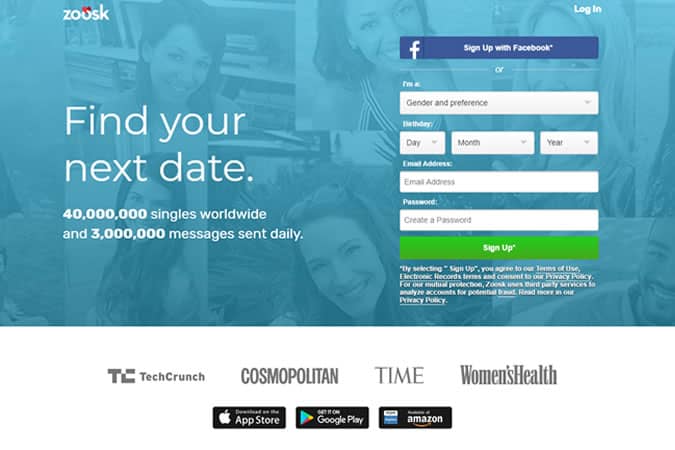Visits: 82
Dating apps are great, they’re like an eye-catching tasting menu where you can sample a little bit of everything you like. Dating sites, however, are more like the trusty local restaurant where the waitress knows your name, order, and your favourite chair.
Tenuous food analogies aside, dating sites are where you go when you want a partner for the long haul, not just an ad break. And best of all, the days when internet dating was seen as, at best embarrassing, and at worst, cringe-worthy are long gone.
So, if your thumb is at risk of repetitive strain injury from endlessly swiping, check out these seven dating sites. We’ll keep an eye out for the wedding invite.
eHarmony
Best For: Curing Swiping Fatigue
Can something that sounds like a manufactured boy band really find you someone to get naked with? Well, cue the dramatic chorus chest-clutching: eHarmony will give it a damn good shot.
The site’s USP is its ‘matching lab’ – a patented pairing system that’s been connecting like-minded singles since US psychologists Drs Neil Clark Warren and Galen Buckwalter realised there must be a way to prevent the incompatibility problems they were seeing in couples counselling.
In 2008, the eHarmony algorithm was anglicised for the UK market (who the Oxford Internet Institute found date differently) but whether you use the app or desktop version, the source of finding a match is the same. Answer 149 character-based questions to have your personality, values and interests mapped against criteria such as how introverted or extroverted you are, how energetic, how ambitious, then get served profiles with similar personality patterns who live within a certain distance.
The Good: eHarmony shows you exactly how your compatibility is broken down – i.e. 95 per cent compatible in intellect, 21 per cent in athleticism. It’s then up to you to decide how important (or not) their preference for doing push-ups rather than gorging on takeout really is.
The Bad: The lack of LGBTQIA+ inclusivity. Same-sex searches are redirected to eHarmony’s sister site, the rather cringingly titled Compatible Partners. And that’s where the diversity starts and ends.

Plenty Of Fish
Best For: Being The Freebie
Let’s be honest, POF (as it’s known in the trade) looks more likely to get you a computer virus than a date. The volume of pop-up ads is worse than trying to watch an illegal football stream, the grammar’s dodgy, and pretty much everything about it screams We Will Steal Your Personal Data.
On the other hand, POF is also the reason why plenty of individuals are happily married. It’s also free and offers up potentials for next Friday night by the screen load.
Seriously, if you need a reminder that you’re not going to die alone clutching a whiskey bottle, get fishing. There are millions of users, and most are under 45.
The Good: Have we mentioned that it’s free? It’s free.
The Bad: The lack of user verification, which makes it spammy. POF doesn’t connect to social media to extract information, nor is there any kind of ID check. So your fishing rod is, basically, cast out into the deep unknown.

Match
Best For: Guaranteeing Success
Match – today’s winner for doing exactly what it says on the tin – may not be new (it was first trialled in the US back during the mid-90s), but it’s gamifying the experience to stay current.
It now has a chatbot, Lara, who can be accessed via Google Assistant to suggest matches (simply tell her your ideal type), offer ideas for where to take a date and generally advise on how not to eff things up.
Match has also introduced the Super Match Badge – a double rose icon that signifies when a bloke has behaved like a gentleman online. Of course you want it. To do so, you need to complete at least 70 per cent of the profile questions (including the personal ad section) and receive one positive comment from a woman in a month.
The Good: Being able to search for users by when they were last logged in. It doesn’t matter how compatible you are if they haven’t been online since 2016.
The Bad: Match’s auto-billing method, which is subject to a lot of online complaints. Check the small print before you check out who’s nearby.

OkCupid
Best For: The Commitment Sweet Spot
OkCupid is a good-looking site with a real fashion magazine aesthetic. That might sound superficial, but it works like a reassuring pat on the back to say, ‘Hey man, it’s fine to be looking online for that thing your smug mate found in a pub/karaoke room/insert other great real-life meet story’.
OkCupid’s algorithm matches potential mates by personality and interests, so it’s worth putting effort into the site’s questionnaires. Luckily they’re more like bar banter than your doctor asking how many units of alcohol you drank last week. Examples: Music festival or sporting event? Would you consider yourself a feminist? As well as serious, heavyweight compatibility factors such as: What are your thoughts on coriander?
The Good: The liberal attitude to gender. You can choose from 22 labels and 13 orientation options, making it the most LGBTQIA+-friendly dating website out there.
The Bad: Recent changes to the site have messed with messaging rules and tanked worse than Hellboy in the opinion polls. Anyone can send a message, but to read a message you’ve been sent, both users have to Like one other. Fine in theory (which was to stop spam), except you can’t see who’s sent the message to ‘Like’ them and read it. Still with us? Basically, it’s all a bit needle in a haystack unless you cough up for the paid version.

Parship
Best For: Something Serious
Parship – not to be confused with the root vegetable – is very much about settling down rather than swiping around. Its method centres around a scientifically formulated algorithm – in this case, called the Parship Principle.
Your job is to spend 20+ minutes answering questions; once done, it will analyse 32 aspects of your personality and then sync you with profiles who balance your attributes – sometimes because they share them, too, but in other cases because you are opposites.
Psychologist Professor Hugo Schmale put 30 years of research into formulating the model, and the results are strong. Parship reports that 38 per cent of its Premium members find a partner with them.
The Good: The level of security. Instead of having your name on your profile, for example, you’re given a user number.
The Bad: Having to be a Premium member to view any photos. The member pool is also annoyingly small outside of major cities.

EliteSingles
Best For: Beauty And Brains
The word ‘Elite’ can make most feel a little uneasy. What do I have to be elite in? And if I’m not elite enough, do I really need a website to reject me as well as my ex? In this case, it’s more a marker of educational level than having model looks/only shopping in WholeFoods/having celebrity pals.
More than three quarters of EliteSingles’ singles (which is definitely not in the elite of easy words to say) have a Bachelor’s degree. Though, if you don’t, it’s fine – you won’t have to bribe the bouncer on the admissions form. That said, getting in is quite lengthy.
There’s a detailed personality test based on the five biggies – neuroticism, openness, conscientiousness, agreeableness and extraversion. The website tots up your answers, relationship preferences and location to provide a tailored selection of matches. Bonus cool part: you also get a full character analysis (basically, free therapy) based on how you do in the quiz, too.
The Good: The openness about the demographic. EliteSingles is clear that 85 per cent of its members are over 30, meaning it’s largely a hook-up- and millennial-free zone.
The Bad: Only getting spoon-fed three to seven matches a day, without the ability to search for yourself. It’s a bit like waiting for an urgent Amazon delivery without getting a time slot.

Zoosk
Best For: Easy Sign-Up
If you’d rather spend your dead time trying to find something to watch on Netflix than revealing details of your inner psyche, you’ll like Zoosk’s onboarding process.
Instead of a lengthy get-to-know-you questionnaire, Zoosk integrates information from your Google and Facebook accounts into your profile, saving you any brainpower beyond remembering your social media log-ins.
Wondering how it finds you good matches? It calls the tech ‘behavioural matchmaking’, and it’s similar to how Amazon looks at your buying past to suggest new things you might like. Zoosk observes who you’re liking, winking at and messaging, then throws as many profiles as possible your way to gauge your reaction to them. While other websites try to psychologically suss you out before you start, Zoosk learns on the job.
The Good: The volume of profiles. When you first start, the conveyor belt of faces is like a Supreme store on drop day.
The Bad: Zoosk has a decent verification system that gives users a green tick of trust. However, even among the verified ones, many are years old and simply haven’t been removed. While faces come at you thick and fast, at times you feel like you’re in a Hollywood movie the morning after a zombie apocalypse.

/**/Continue Reading

